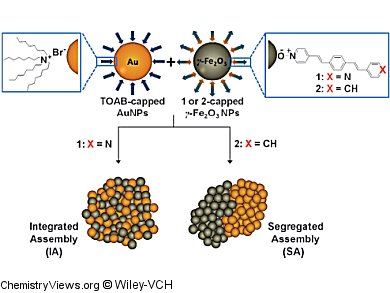Multicomponent materials might display synergistic effects and possess functions not attainable with single-component systems. Control over the composition and structure of such materials is not trivial because many factors are involved.
Milko E. van der Boom and colleagues, Weizmann Institute of Science, Rehovot, Israel, have demonstrated that the structural arrangement of Au/γ-Fe2O3 binary nanoparticle (NP) assemblies can be controlled as a function of the capping layer. This results in integrated and segregated assemblies. The use of orthogonal coordination chemistry resulted in the formation of integrated assemblies, whereas the use of NP-ligand coordination or π–π stacking resulted in well-separated domains (segregated assemblies). This formation of segregated assemblies reflects the importance and the use of hierarchical forces for phase-separation with NPs.
The systems were designed to comprise both the optical properties of AuNPs and the magnetic properties of γ-Fe2O3 NPs.
The assemblies were characterized by combining UV/Vis spectroscopy, transmission electron microscopy (TEM), energy dispersive X-ray spectroscopy (EDS), and cryogenic- (cryo-) TEM.
- Integrated and Segregated Au/γ-Fe2O3 Binary Nanoparticle Assemblies,
Meital Boterashvili, Michal Lahav, Tanya Shirman, Dalia Freeman, Milko E. van der Boom,
Angew. Chem. Int. Ed. 2012.
DOI: 10.1002/anie.201207469




